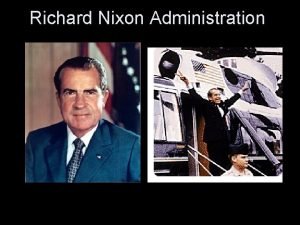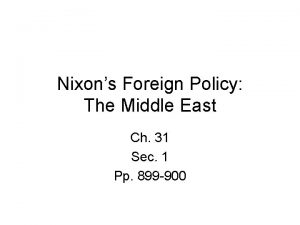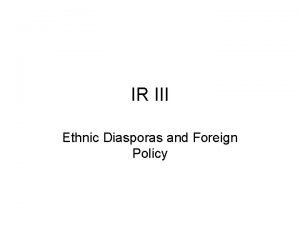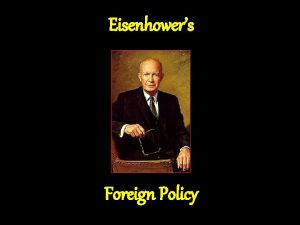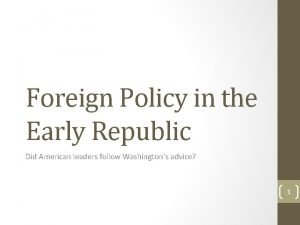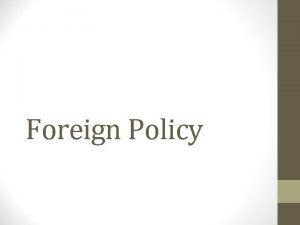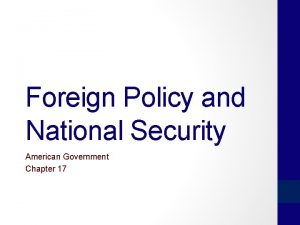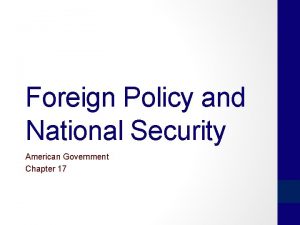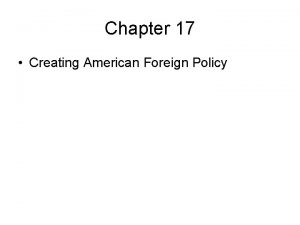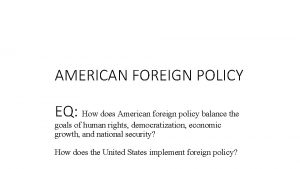Foreign Policy and National Security AMERICAN GOVERNMENT CHAPTER


















- Slides: 18

Foreign Policy and National Security AMERICAN GOVERNMENT CHAPTER 17 SECTION 1 MR. DEEL

Pre-Assessment �Please fill out this paper in order to show what you know!

What is Foreign Policy? �Foreign Policy is all the actions, affairs, and stands that the U. S. takes in its relations with other nations. �Foreign Policy incorporates many programs, departments, business aspects, and many other aspects of our governmental relations. (Vague) �Department of Foreign Affairs was created in 1781 Under the Articles of Confederation.

Domestic vs. Foreign Affairs �Domestic Affairs- The relations and policies that the U. S. has amongst itself. �Ex. Education, Civil Rights, Taxes �Foreign Affairs- The relations that the U. S. has with other nations. �Ex. Trade, Oil, Peace

Isolationism vs. Internationalism �Isolationism- A purposeful refusal to become generally involved with the rest of the world. �Ex. U. S. hesitation to enter World War I �Internationalism- The thought that the well being of the U. S. is affected by what goes on in the rest of the world. �Ex. World War II, War on terrorism

Discussion Question #1 �Why do you think the U. S. abandoned isolationism and pursued internationalism?

The State Department is headed by the Secretary of State. Advises the President on foreign policy and carries out his policies through its diplomats abroad. On February 1, 2013 John Kerry became the new U. S. Secretary of State.

The State Department �The President selects the Secretary of State, with the approval by the Senate. � 1 st Executive Department created by congress �Right of Legation- The right to send and receive diplomatic representatives. �Ambassador- Official representative of the U. S. appointed by the President to represent the nation in matters of diplomacy. (180+ Countries)

U. S. Ambassador to Libya Killed September 11, 2012 in Benghazi, Libya by militant group linked to terror extremists Eighth ambassador ever to be killed in the line of duty Sparked thoughts of higher security for U. S. Ambassadors J. Christopher Stephens

Passports and Diplomatic Immunity �Passport- is a certificate issued by the government to citizens who choose to travel or live abroad. Entitles citizens to privileges given by international customs/treaties. �Diplomatic Immunity- The exception to right of legation. This states that Ambassadors can’t be arrested, sued, or taxed as they are there on official business. However, country can kick them out.

The Defense Department is headed by the Secretary of Defense. The Secretary of Defense is the President’s chief advisor on military matters. The Defense Department was created to unify the nation’s armed forces On February 27, 2013 Chuck Hagel became U. S. secretary of defense. The Defense Department operates out of the Pentagon in Arlington, Virginia. The Defense Department

Defense Spending

The Military Departments �Set into place to protect our country �Each headed by a civilian secretary that reports directly to the Secretary of Defense �Made up by the Departments of: � 1. The Army � 2. The Navy � 3. The Air Force

The Army �The Army is the oldest and largest of the three forces. �Mainly group forces whose objectives are to defeat any attack on the U. S. , while using forceful action in matters abroad.

The Navy �Major Objectives: � 1. Seize or defend land bases from which the fleet can operate. � 2. To carry out land campaigns using their combat ready land force, The Marines.

The Air Force �The youngest of the military forces, but is the nation’s first line of defense. �Objectives are to protect the U. S. and to defeat enemy air, ground, and sea forces. �Also, they strike war-related targets in enemy territories, and transport and support land naval operations.

Fill-in-the-blank Worksheet �With a partner, please fill out the fill-in-the-blank worksheet. �Use your notes to find key terms for answers.

Quiz Time �Please complete the quiz and wait quietly until everyone is finished. �Thank you for your attention, participation, and cooperation.
 Unit 4 lesson 10 american foreign policy
Unit 4 lesson 10 american foreign policy Lesson 5: american foreign policy
Lesson 5: american foreign policy Electronic commerce security
Electronic commerce security What are the three levels of government
What are the three levels of government Chapter 33 section 4 foreign policy after the cold war
Chapter 33 section 4 foreign policy after the cold war Too foreign for home too foreign for here
Too foreign for home too foreign for here Privat security
Privat security 1790 foreign policy
1790 foreign policy Foreign policy of louis philippe
Foreign policy of louis philippe What was thomas jefferson foreign policy
What was thomas jefferson foreign policy Nixons foreign policy
Nixons foreign policy Nixons foreign policy
Nixons foreign policy Actors in foreign policy
Actors in foreign policy Definition of foreign policy by scholars
Definition of foreign policy by scholars Actors in foreign policy
Actors in foreign policy Truman foreign policy vs eisenhower
Truman foreign policy vs eisenhower Interwar foreign policy
Interwar foreign policy Hitler's foreign policy timeline
Hitler's foreign policy timeline Foreign policy in the early republic
Foreign policy in the early republic










